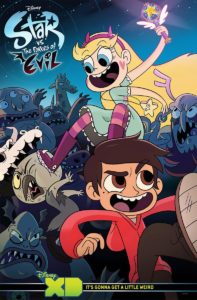 You know what I miss most about being a kid? Saturday morning cartoons. Sitting down with a bowl of cereal at eight in the morning and turning on ABC’s Kids or Fox Kids or any other combination of a television channel and the word Kids and watching cartoons until the sun reached its peak at noon. With Netflix and Hulu at the touch of a button, I have tried to recreate that experience with a line-up of kids cartoons; granted, much more modern than DuckTales and Tale Spin. One of the shows I’ve come across is Star vs. the Forces of Evil! A modern Disney cartoon well on its way to a fourth season, the show focuses on a 14 year old princess from another dimension named Star who comes to Earth to complete her education on how to be proper royalty. Properly animated (none of that flash animation crap) and hyper-active, this little cartoon is perfect for those of us who want to be both a magical princess and a road warrior!
You know what I miss most about being a kid? Saturday morning cartoons. Sitting down with a bowl of cereal at eight in the morning and turning on ABC’s Kids or Fox Kids or any other combination of a television channel and the word Kids and watching cartoons until the sun reached its peak at noon. With Netflix and Hulu at the touch of a button, I have tried to recreate that experience with a line-up of kids cartoons; granted, much more modern than DuckTales and Tale Spin. One of the shows I’ve come across is Star vs. the Forces of Evil! A modern Disney cartoon well on its way to a fourth season, the show focuses on a 14 year old princess from another dimension named Star who comes to Earth to complete her education on how to be proper royalty. Properly animated (none of that flash animation crap) and hyper-active, this little cartoon is perfect for those of us who want to be both a magical princess and a road warrior!
Like most of today’s kids cartoons, e.g. Adventure Time or Gravity Falls, Star isn’t just a series of one-shots, but also contains an overarching arc that plays through the undercurrent of the show. As stated, the show focuses on Star, a Sailor Moon inspired princess who lives on Earth with her new family, the Diaz’s, and causes mischief wherever she goes. She and her friend Marco Diaz spend their days getting in and out of trouble, exploring both the magical and non-magical worlds, and generally goofing off. She also has her own consistent bad guy a la Ice King, this one in the form of a bald, bird beaked, little man named Ludo who is constantly attempting to steal Star’s wand. Devious! With Ludo in and out her life and the pressure of being the new Queen of her home world looming, it seems like Star’s troubles are just starting!
I’ve watched a lot of cartoons in my day and I hafta say, Star vs the Forces of Evil is by far one of my favorites. Star is the best weird girl that’s ever been animated onto the small screen. From her goofy headwear and colorful dresses to her constantly changing themed bags, her design is fun and quirky without making her too obnoxious. Her creator, Daron Nefcy, was heavily inspired by magical girl manga, with many manga elements going into her creation such as her over-the-top personality and offbeat voice. Her friend Marco, who changes from a safety conscious side-kick to martial arts enthusiast, was also inspired by fan boys of Dragonball Z. Together, they learn lessons about life and each other and solve their problems within an 11 minute window without repeating the same story twice.
The side characters are also fully fleshed out and help contribute to the overall feel of the show, with some even getting their own episodes. In season 2, we get to what happened to Ludo after the first season finale and Stars on-and-off enemy Buff Frog gets his own episodes as he struggles to provide for his children. Of course, it wouldn’t be a proper magical girl show without a couple of romances involved and both Star and Marco deal with their feelings for other characters (and eventually, for each other). Essentially, it’s what you would expect from a current kids cartoon and I love that today’s creators are just old cartoon nerds like the rest of us. The show doesn’t underestimate its viewers, both children and adults, and understands that shows can be both complex and fun. Throw in some puppies that shoot lasers and have hearts on their buttholes and you got yourself a show!
Production wise, Star vs. didn’t skimp on any details, but then again, it is owned by Disney. The animation is fluid and punchy with just the perfect amount of noodle arms. It lacks the stretch and squash animation of traditional Disney animation which, frankly, would’ve looked goofy with this type of storytelling. The character designs are largely unique from one another and they all look age appropriate, so no 16 year old Gwen Stacy’s in a barely-there bikini. Perhaps the only real complaint is the first several episodes of Season 2 seem to suffer musical composition problems where long strings of scenes that should have musical accompaniment end up being mostly silent, making the episodes awkward to watch. I never realized how important music is to a cartoon until you don’t hear any, it was super weird. Luckily, the problem gets fixed by the fourth or fifth episode and the rest is smooth sailing.
If you’re looking for an all-ages cartoon for your weirdo kids, look no further than Star VS the Forces of Evil! The first three seasons are now on Hulu.
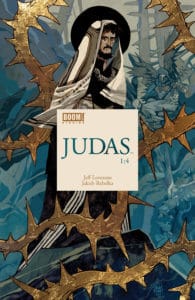 There are three things that are never supposed to be discussed in polite company: money, politics, and religion. But, when those three things make up the majority of a person’s life, when they shape the very soul and beliefs of a human being, how do you go about ignoring them entirely, especially when you have a whole different side of the story to tell? BOOM! Studios’ newest comic preaches that story from the last person you would imagine: Judas Iscariot. Told from the perspective of the greatest enemy of Christianity (short of the Devil in a bowler hat), we learn that not everyone blindly believed the words of the Prophet and how those words can easily change from self-sacrificing to self-serving. A unique look at a time of Roman conquerors and prophetic madmen, Judas doesn’t shy away from asking the hard questions about faith and miracles while pondering that age old question, if the Son of God can perform miracles, why does he allow people to suffer?
There are three things that are never supposed to be discussed in polite company: money, politics, and religion. But, when those three things make up the majority of a person’s life, when they shape the very soul and beliefs of a human being, how do you go about ignoring them entirely, especially when you have a whole different side of the story to tell? BOOM! Studios’ newest comic preaches that story from the last person you would imagine: Judas Iscariot. Told from the perspective of the greatest enemy of Christianity (short of the Devil in a bowler hat), we learn that not everyone blindly believed the words of the Prophet and how those words can easily change from self-sacrificing to self-serving. A unique look at a time of Roman conquerors and prophetic madmen, Judas doesn’t shy away from asking the hard questions about faith and miracles while pondering that age old question, if the Son of God can perform miracles, why does he allow people to suffer?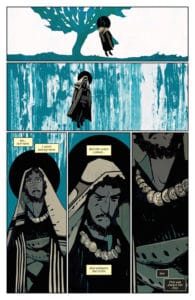 In fact, the whole work asks questions that have never really be asked before. Why did Jesus pick Judas to martyr him? Did he know that Judas did not have the same level of belief as the rest of his disciples? Was Jesus trying to change Judas faith in him or was he banking on the fact that he couldn’t? All these thoughts flit not only in Judas’s brain, but force their way into the readers as well. You really can’t help but sympathize with Judas, especially when he’s clawing through the mountains of Hell not really knowing why he’s there. He honestly thinks he did what Jesus wanted him to do. Then again, there is a wonderful ‘unreliable narrator’ angle in the story as well, where, despite what he says, one can’t help remember that he freaking killed Jesus! Even he is forced to realize that he did something pretty horrendous, hence the suicide in the beginning. Maybe he really was just an evil man? How do you justify killing God?
In fact, the whole work asks questions that have never really be asked before. Why did Jesus pick Judas to martyr him? Did he know that Judas did not have the same level of belief as the rest of his disciples? Was Jesus trying to change Judas faith in him or was he banking on the fact that he couldn’t? All these thoughts flit not only in Judas’s brain, but force their way into the readers as well. You really can’t help but sympathize with Judas, especially when he’s clawing through the mountains of Hell not really knowing why he’s there. He honestly thinks he did what Jesus wanted him to do. Then again, there is a wonderful ‘unreliable narrator’ angle in the story as well, where, despite what he says, one can’t help remember that he freaking killed Jesus! Even he is forced to realize that he did something pretty horrendous, hence the suicide in the beginning. Maybe he really was just an evil man? How do you justify killing God? There’s nothing cheesier than starting a conversation with the words “hey, do you remember the 90s?” But really, do you, 90s kids? Remember Rugrats, Gakk, getting slimed, or that spinning thing that twirled around your leg and counted how many times you jumped over it? What was the point of that thing? Anyway, as the wave of nostalgia keeps washing over us like cans of Crystal Pepsi, so are the creators at BOOM! Studios working hard to remind us of a time when our only worries were catching the latest episode of Power Rangers and dying from a sugar rush. With the recent “comicizations” of our favorite childhood shows, it’s only a matter of time before Rocko’s Modern Life sees a revival itself (and not just in the upcoming one hour cartoon set to hit in 2018). As I sat down with the first issue of what is sure to be one of many upcoming stories, I’m surprised to report that it was actually pretty damn good. Have I finally fallen into the nostalgia trap that has kept Transformers alive WAY longer than it should have, or was this actually a good comic? Honestly, I think it’s a little bit of both but I’m happy to say that I don’t regret reading it.
There’s nothing cheesier than starting a conversation with the words “hey, do you remember the 90s?” But really, do you, 90s kids? Remember Rugrats, Gakk, getting slimed, or that spinning thing that twirled around your leg and counted how many times you jumped over it? What was the point of that thing? Anyway, as the wave of nostalgia keeps washing over us like cans of Crystal Pepsi, so are the creators at BOOM! Studios working hard to remind us of a time when our only worries were catching the latest episode of Power Rangers and dying from a sugar rush. With the recent “comicizations” of our favorite childhood shows, it’s only a matter of time before Rocko’s Modern Life sees a revival itself (and not just in the upcoming one hour cartoon set to hit in 2018). As I sat down with the first issue of what is sure to be one of many upcoming stories, I’m surprised to report that it was actually pretty damn good. Have I finally fallen into the nostalgia trap that has kept Transformers alive WAY longer than it should have, or was this actually a good comic? Honestly, I think it’s a little bit of both but I’m happy to say that I don’t regret reading it. 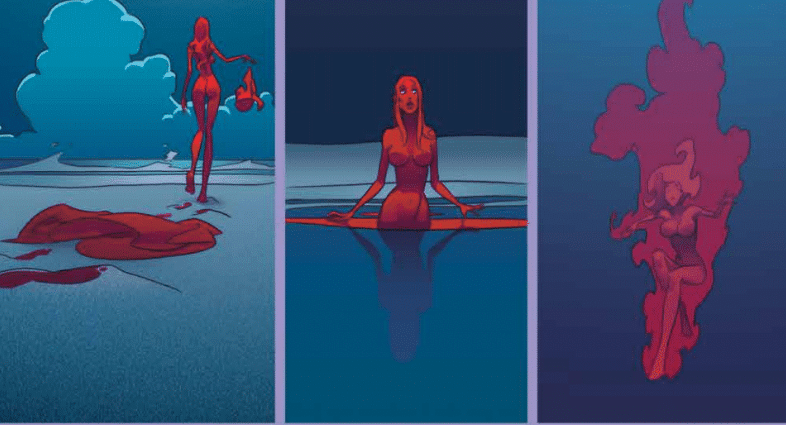 I gotta admit, when I first saw the title for Image’s newest vampire comic Dark Fang, I pictured a half-dressed, big-tittied vamp babe swinging a hatchet around and lamenting on being deathless or some garbage. Either that, or a comic about a fifteen year old going through some very rough puberty and bad fashion. Luckily, I was only partially right! There’s plenty of blood and some tits in it, but the work moves past the typical vampire tropes and explores a world fraught with social issues, proving that sexy monsters are the least of society’s worries. While perhaps not the first comic to explore worldly issues through the “who’s-the-real-monster” trope a la Swamp Thing, Dark Fang has a little fun with the genre by mixing humor and fast paced illustration while allowing for the reader to self-reflect without feeling too guilty. Unfortunately, releasing the work in today’s climate, in which every time you turn around there’s another natural disaster or social media firestorm, it’s kind of hard to care about what the comic is trying to sell.
I gotta admit, when I first saw the title for Image’s newest vampire comic Dark Fang, I pictured a half-dressed, big-tittied vamp babe swinging a hatchet around and lamenting on being deathless or some garbage. Either that, or a comic about a fifteen year old going through some very rough puberty and bad fashion. Luckily, I was only partially right! There’s plenty of blood and some tits in it, but the work moves past the typical vampire tropes and explores a world fraught with social issues, proving that sexy monsters are the least of society’s worries. While perhaps not the first comic to explore worldly issues through the “who’s-the-real-monster” trope a la Swamp Thing, Dark Fang has a little fun with the genre by mixing humor and fast paced illustration while allowing for the reader to self-reflect without feeling too guilty. Unfortunately, releasing the work in today’s climate, in which every time you turn around there’s another natural disaster or social media firestorm, it’s kind of hard to care about what the comic is trying to sell. 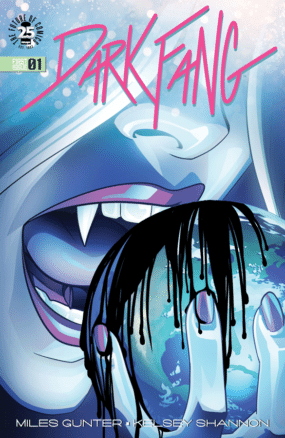 So, while there are definitely a good few laughs, mostly focusing on Vanna as she learns the ins and outs of modern society, Dark Fang is pretty heavy handed with the social issues. Every side character is buried in their phones, men (and some women) roam the internet looking for sex, and everyone is, well, kind of shitty. Money seemingly buys you everything you want; but of course, the lesson that Vanna needs to learn is that it can’t. The comic is billed as an “action-horror middle finger to the politicians and propagandists who choose to deny the reality of climate change,” although to be fair, the first issue doesn’t really cover much climate change (aside from the oil spill which is more of an environmental disaster), but you get it. That’s where it’s going with it. I GET it and that’s the problem. This comic is aimed at people who are in an echo chamber. Of course we think climate change is real, of course oil spills and money cause a lot of problems, we hear it from the same news sources that the writers do. It’s the same thing that we deal with every day and having a comic tell me AGAIN, even with a sexy vampire mermaid, I just don’t care about its message. That’s not to say that these issues aren’t important, they are incredibly important and very much need to be addressed, but with this comic, it’s just the same old ground over and over. Dark Fang assumes that we haven’t addressed the issues, but we have, for decades, and we’re past awareness and now want to move on to action.
So, while there are definitely a good few laughs, mostly focusing on Vanna as she learns the ins and outs of modern society, Dark Fang is pretty heavy handed with the social issues. Every side character is buried in their phones, men (and some women) roam the internet looking for sex, and everyone is, well, kind of shitty. Money seemingly buys you everything you want; but of course, the lesson that Vanna needs to learn is that it can’t. The comic is billed as an “action-horror middle finger to the politicians and propagandists who choose to deny the reality of climate change,” although to be fair, the first issue doesn’t really cover much climate change (aside from the oil spill which is more of an environmental disaster), but you get it. That’s where it’s going with it. I GET it and that’s the problem. This comic is aimed at people who are in an echo chamber. Of course we think climate change is real, of course oil spills and money cause a lot of problems, we hear it from the same news sources that the writers do. It’s the same thing that we deal with every day and having a comic tell me AGAIN, even with a sexy vampire mermaid, I just don’t care about its message. That’s not to say that these issues aren’t important, they are incredibly important and very much need to be addressed, but with this comic, it’s just the same old ground over and over. Dark Fang assumes that we haven’t addressed the issues, but we have, for decades, and we’re past awareness and now want to move on to action. 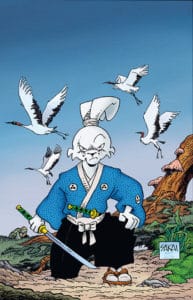 There are very few independent comics that have survived to their 30 year mark like Usagi Yojimbo. In fact, I’m hard pressed to think of anything outside of Love and Rockets and Judge Dredd, which makes the samurai-laden, anthropomorphic action epic that is Usagi that much more special. That being said, I have the distinct honor of never having read an issue. Not for any particular reason, I just have never picked up an issue despite having many, many opportunities (of course, it seems like Usagi does just fine without my business) so when I heard that issue 163 was the perfect jumping on point, I decided to finally see what I was missing out on. As it turns out, quite a lot! Usagi Yojimbo is a great, low flying comic about a samurai bunny named Miyamoto Usagi that travels Japan and helps out wherever he can. In the latest issue, we find our hero helping out in a town plagued with a Robin Hood type thief who’s framed for something that he didn’t do.
There are very few independent comics that have survived to their 30 year mark like Usagi Yojimbo. In fact, I’m hard pressed to think of anything outside of Love and Rockets and Judge Dredd, which makes the samurai-laden, anthropomorphic action epic that is Usagi that much more special. That being said, I have the distinct honor of never having read an issue. Not for any particular reason, I just have never picked up an issue despite having many, many opportunities (of course, it seems like Usagi does just fine without my business) so when I heard that issue 163 was the perfect jumping on point, I decided to finally see what I was missing out on. As it turns out, quite a lot! Usagi Yojimbo is a great, low flying comic about a samurai bunny named Miyamoto Usagi that travels Japan and helps out wherever he can. In the latest issue, we find our hero helping out in a town plagued with a Robin Hood type thief who’s framed for something that he didn’t do.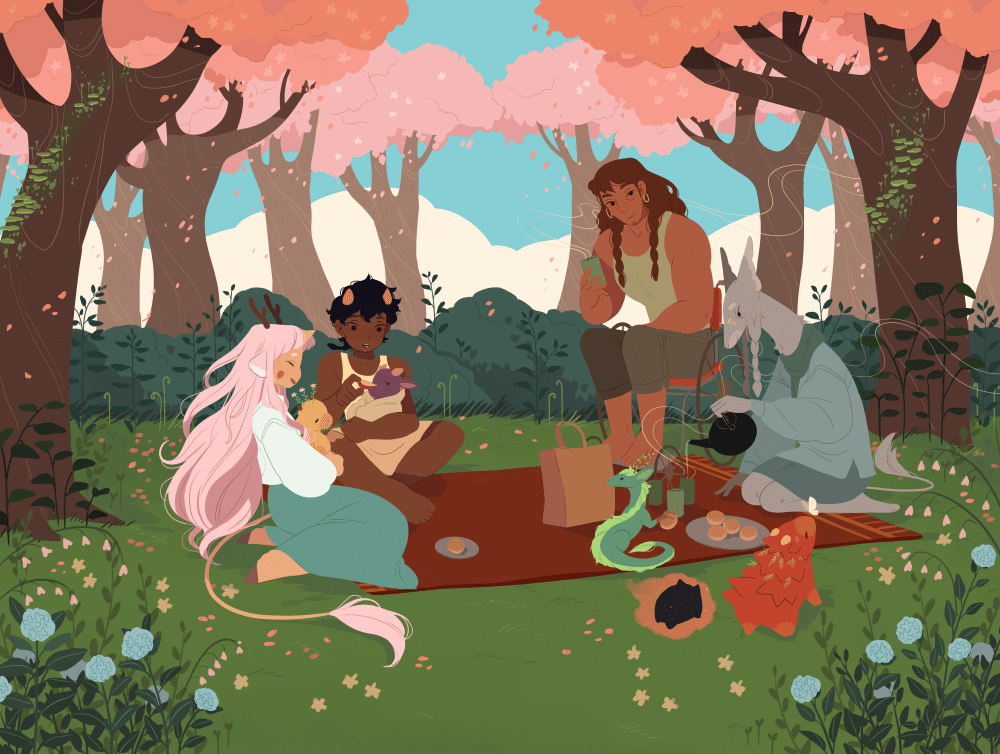 Alright everyone, buckle up, because I’m pretty sure I just read the cutest thing ever. Here at Warped Perspective, we are very open to all kinds of entertainment as long as it’s unique and a little weird, so this is, by FAR, the least scary thing to have ever been made, but GEEZ, is it cute. It’s fantasy cute! It’s a make toys out of it and cross-stitch the flowers cute! It’s vomiting rainbows cute AND it has dragons in it! And they are adorable! The Tea Dragon Society, IDW’s recent masterpiece of fantasy and cute girls, invites the reader into a world not torn by war or evil wizards, but instead, where tea is always served and a friend is never too far away. There’s almost no action and instead focuses on the beauty of a magical world that is enjoying a time of peace and prosperity and how one might grow up in it. With, dare I say, perfect illustrations, this all-ages comic is the perfect mellow down book for sweet dreams and tough days.
Alright everyone, buckle up, because I’m pretty sure I just read the cutest thing ever. Here at Warped Perspective, we are very open to all kinds of entertainment as long as it’s unique and a little weird, so this is, by FAR, the least scary thing to have ever been made, but GEEZ, is it cute. It’s fantasy cute! It’s a make toys out of it and cross-stitch the flowers cute! It’s vomiting rainbows cute AND it has dragons in it! And they are adorable! The Tea Dragon Society, IDW’s recent masterpiece of fantasy and cute girls, invites the reader into a world not torn by war or evil wizards, but instead, where tea is always served and a friend is never too far away. There’s almost no action and instead focuses on the beauty of a magical world that is enjoying a time of peace and prosperity and how one might grow up in it. With, dare I say, perfect illustrations, this all-ages comic is the perfect mellow down book for sweet dreams and tough days.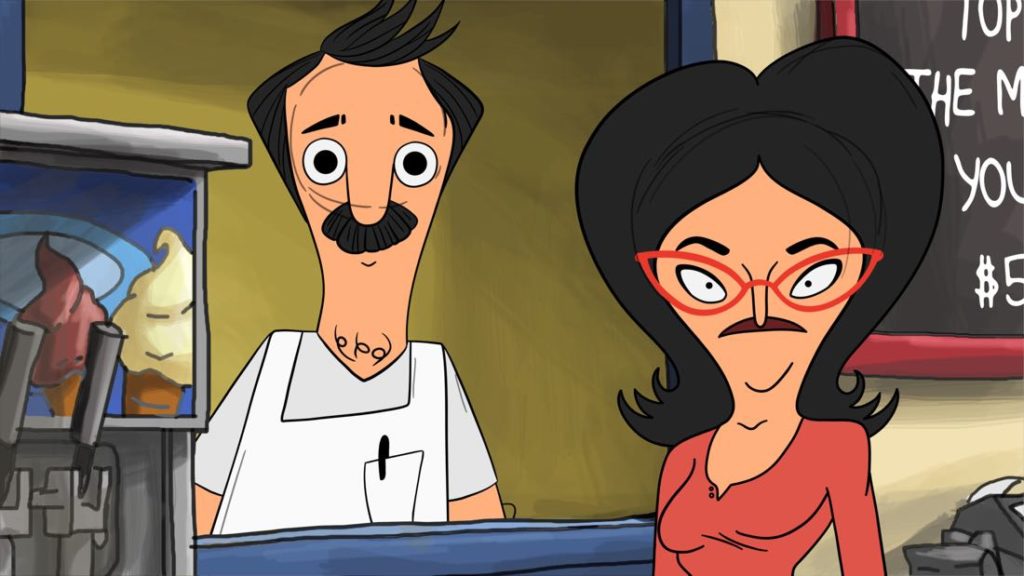 As stated, the premier was rather simple and maintained the entire episode within the walls of the restaurant and the house, making it easier on the animators to focus on only on two locations. The fun part was that the creators weren’t looking for outstanding or professional works by people who have been in the animation industry for two decades, but actual fans; as a result, there’s all manner of weird and goofy-looking animation on top of some pretty stellar, even cute work. There was even a bit of Claymation and felt creations added to the mix. The line work and coloring ranged from flash animation to crayon and marker, as if some kid scribbled out a piece. Mostly, it was just fun to see the different takes on the same characters, especially when the drawings are realistic and you get to see the family as actual people.
As stated, the premier was rather simple and maintained the entire episode within the walls of the restaurant and the house, making it easier on the animators to focus on only on two locations. The fun part was that the creators weren’t looking for outstanding or professional works by people who have been in the animation industry for two decades, but actual fans; as a result, there’s all manner of weird and goofy-looking animation on top of some pretty stellar, even cute work. There was even a bit of Claymation and felt creations added to the mix. The line work and coloring ranged from flash animation to crayon and marker, as if some kid scribbled out a piece. Mostly, it was just fun to see the different takes on the same characters, especially when the drawings are realistic and you get to see the family as actual people.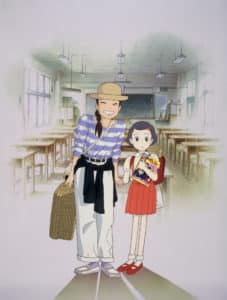 As stated, Only Yesterday is a movie that falls in line with the more slower-paced Ghibli works such as My Neighbors the Yamadas and Whisper of the Heart. It forgoes using outside elements such as war or illness as a driving force, and instead focuses inward in an attempt to make a movie that is very relatable to the viewer. It’s a simple story about a woman who has reached a turning point in her life. She is attempting to align what she had hoped for as a young girl with what she now has the opportunity to do, while trying to figure out where her true obligations lie. She tells stories of her younger self when the proper opportunity arises, each one ranging from cute and funny to kind of sad, and manages to bring it back to where she is now. It’s an interesting, multi-layered work, like Eat Pray Love but as an anime. Much like Eat Pray Love, there is a ton of dialogue which, at times, seems to go nowhere. There’ll be five to ten minute intervals of just conversation between Taeko and whoever is around, so do make sure to have some patience.
As stated, Only Yesterday is a movie that falls in line with the more slower-paced Ghibli works such as My Neighbors the Yamadas and Whisper of the Heart. It forgoes using outside elements such as war or illness as a driving force, and instead focuses inward in an attempt to make a movie that is very relatable to the viewer. It’s a simple story about a woman who has reached a turning point in her life. She is attempting to align what she had hoped for as a young girl with what she now has the opportunity to do, while trying to figure out where her true obligations lie. She tells stories of her younger self when the proper opportunity arises, each one ranging from cute and funny to kind of sad, and manages to bring it back to where she is now. It’s an interesting, multi-layered work, like Eat Pray Love but as an anime. Much like Eat Pray Love, there is a ton of dialogue which, at times, seems to go nowhere. There’ll be five to ten minute intervals of just conversation between Taeko and whoever is around, so do make sure to have some patience.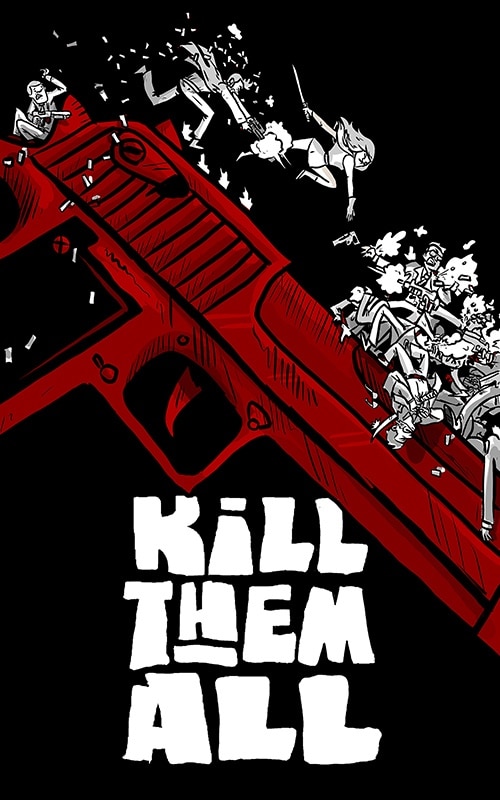 If there was one constant theme in today’s (or at least this quarter’s) comic market, it’s vengeance comics. Works such as Sisters of Sorrow and Made Men have been blazing the comic shelves, each one adding its own twist on the well-worn idea. Oni Press’s newest graphic novel, Kill Them All, though, seems intent to powerhouse all of them into a headlock and take the throne for itself. While, unfortunately, it’s not a rendition of Metallica’s debut album through the illustrated medium (though how badass would that be?), it is a fantastically bloody, quick-witted, and kung-furied piece of art that hearkens back to old 90s action flicks and Old Boy-esque digs. While it doesn’t muse on the art of violence such as Sisters of Sorrow or have cool monsters like Made Men, it does bring back something that revenge titles have long left behind: it’s pretty damn funny.
If there was one constant theme in today’s (or at least this quarter’s) comic market, it’s vengeance comics. Works such as Sisters of Sorrow and Made Men have been blazing the comic shelves, each one adding its own twist on the well-worn idea. Oni Press’s newest graphic novel, Kill Them All, though, seems intent to powerhouse all of them into a headlock and take the throne for itself. While, unfortunately, it’s not a rendition of Metallica’s debut album through the illustrated medium (though how badass would that be?), it is a fantastically bloody, quick-witted, and kung-furied piece of art that hearkens back to old 90s action flicks and Old Boy-esque digs. While it doesn’t muse on the art of violence such as Sisters of Sorrow or have cool monsters like Made Men, it does bring back something that revenge titles have long left behind: it’s pretty damn funny.